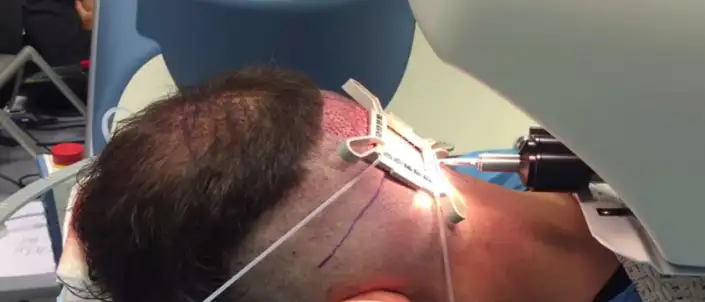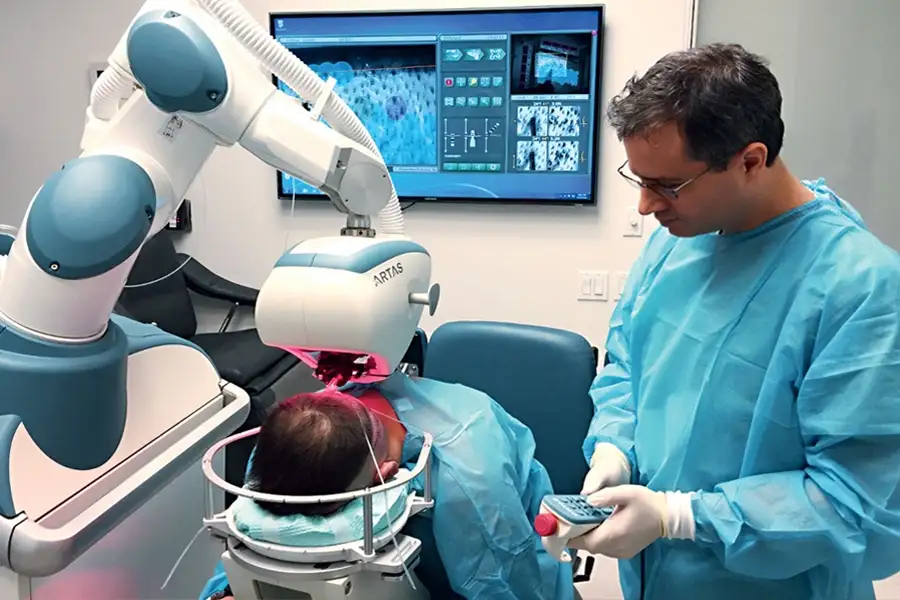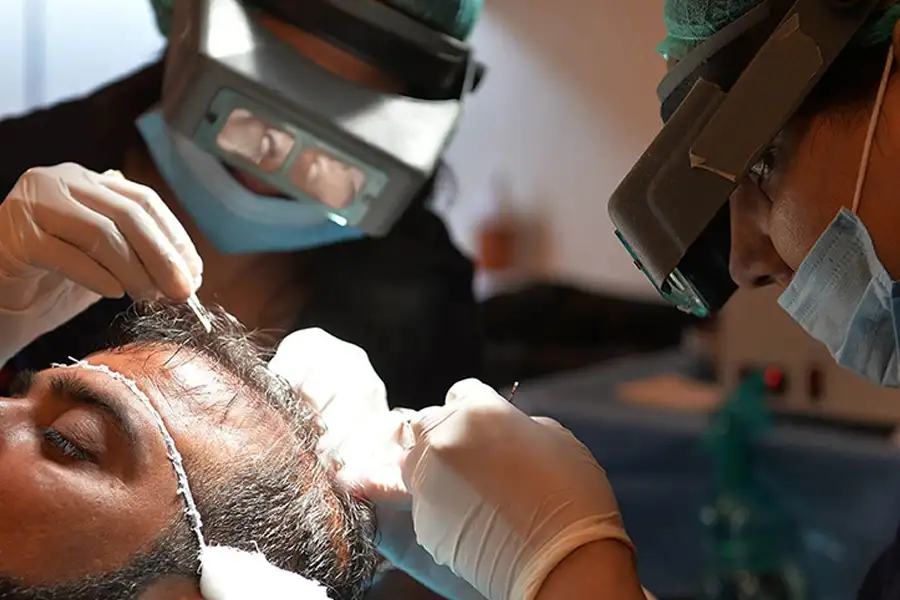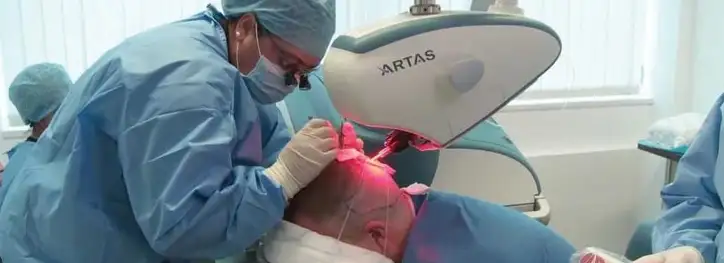
What is a Robotic hair transplant technique? Process Steps and Cost of 2024
Hair loss is becoming a problem faced by both men and women today. They are looking for a permanent solution because hair also affects people's self-confidence. With the recently developing technology, people can achieve the appearance they want by applying various hair methods. The Robotic hair transplant method is one of these methods.
What is the Robotic Hair Transplant Method?

The Robotic hair transplant Method is performed with 3D technology. In the Robotic hair transplant technique, hair follicles from the donor area and transplanted into the recipient area. The Robotic hair transplant technique is a state-of-the-art product; It gives less margin of error than other hair transplant techniques. Sensitivity becomes more minimized than other processes.
In the Robotic hair transplant method, the robot determines the direction of hair growth and the angle from which the transplant will be made. During the hair implant, the hair should be transplanted towards the direction of growth. Performing hair implants in the direction of hair growth will provide a more natural appearance. The specialist doctor manually transplants the hair follicles from the donor area to the recipient area.
At this stage, the doctor's expertise and attentive working style are an important element to achieve the desired image. Before a hair implant, the patient is photographed from three different angles. Hair analysis is performed according to the photos taken from the front, back, and side. How much hair will be transplanted to which area is determined and a decision is made. With the Robotic hair method, the hair follicles are seen more clearly and the transplant processes are more comfortable. Another feature of the Robotic hair transplant method is that the c hair follicles are healthy. Robot used in hair implant; While collecting hair follicles from the graft area, it selects healthy hair and performs the procedure without damaging other hair follicles.
The margin of error in Robotic hair transplant is very low compared to other hair method. At the same time, this hair method will be more painless and comfortable for patients. During the hair surgery, the robot works in line with the given positions, but in a possible situation, the doctor performing the hair implant can intervene. In the Robotic hair transplant technique, all stages take place within 1 day and the operation takes an average of 7 hours.
Robotic hair transplant Turkey has become indispensable for patients. Patients who want to have the procedure prefer Turkey.
Robotic Hair Transplant and Its Advantages
As with other hair methods, the Robotic hair method has advantages and disadvantages.
- Since it is more practical than other hair methods, the Robotic hair transplant technique is seen as the latest wonder of technology in hair clinics.
- The Robotic DHI hair transplant method gives less margin of error compared to other techniques.
- In the Robotic hair method, while grafts are collected from the area, it does not damage the healthy hair follicles in the collected area, but in other hair methods, other hair follicles may be damaged in some cases, albeit at a minimum level.
- Before the hair procedure, the patient is photographed from three different angles. The analysis is carried out according to the photos taken. The number of grafts is calculated, and planning is made for hair implants.
- Compared to other hair implant methods, the recovery time is shorter in Robotic hair transplant techniques.
- As a result of a Robotic hair transplant, a natural appearance is obtained.
- In Robotic DHI hair transplant, hair follicles are collected from a depth of 1.5mm, while in the DHI and Saphir hair method, hair follicles are collected from a depth of 3mm. Since the Robotic hair transplant method does not go deep, pitting is not observed.
- In a Robotic DHI hair transplant, the patient recovers very quickly. You can go to work 1 day after the hair surgery. It does not collect edema in the face area after the operation. While swelling is experienced in the eyes and forehead area in other hair ımplant, no swelling occurs in the Robotic hair transplant method.
What are the Robotic Hair Transplant Method and Application Stages?

- Before hair procedures, hair analysis is performed on the patient.
- As a result of the analysis, the area to be transplanted is prepared.
- The area to be transplanted is marked.
- Hair is shaved.
- Local anesthesia is given to the patient so that the patient does not feel pain and pain during the operation.
- After anesthesia is given, the hair surgery is started.
- All hair surgery stages are monitored on the screen. In possible cases that may need to be intervened, the specialist doctor and his team may be involved.
- In the Robotic DHI hair transplant method, grafts are not collected manually as in other methods. While collecting the grafts, procedures are performed with a mechanical arm, a tool for opening channels, and a monitor. Grafts are not collected by the doctor, they are collected by the robot.
The Robotic hair transplant technique consists of 5 stages:
Hair and Photo Shoot
Before the Robotic hair procedure, the patient's photographs are taken from the front, back, and side. The photos are transferred to the robot's memory and the hair surgery is programmed, and the way to treat the hair is determined at this stage. Thus, the area to be planted becomes 3D.
Donor Area
The hair structure reflected on the screen in 3D and the density of the hair are examined. It is calculated how many grafts will be added to the recipient area, and then the hair is collected from the donor area.
Collection of Grafts
With the Robotic DHI hair transplant method, the grafts to be collected are determined and the direction and exit angles of the hair follicles are determined. The robot collects the hair follicles according to the calculations made. Robots have a vacuum feature. Hair follicles are collected using a double-chamber needle.
Opening of Channels
After determining the number of grafts to be collected, the grafts are collected from the area and channels are opened to the bald area where hair surgery will be performed. As in other procedures, a Robotic DHI hair transplant is performed with manual and micromotor methods.
Grafts and Transplant Process
In the Robotic hair method, the collected grafts are transferred to the opened channels, and the hair surgery is completed after the transplanted grafts are transferred to the recipient area. In the next process, care is provided as in other hair method.
Robotic Hair Transplant Technique and Disadvantages
- Since the latest version technological device is used in the Robotic hair transplant method, it is more expensive compared to other methods.
- Robotic DHI hair transplant cost are higher than other methods.
- Although the procedure is performed with a robot, an experienced surgeon and his team are needed.
- When determining the front hairline, the specialist doctor performs the procedure. It cannot determine the robot's hairline.
- Since it is a new technological development, the variety of clinics is limited. It may not give as permanent results as the FUE method.
Robotic Hair Transplant and Successful Results

One of the most important features that distinguishes a Robotic hair transplant from other methods is that in the DHI and Saphir methods, hair follicles from the donor area, while sometimes damaging other healthy hair follicles, but such a problem is not encountered in a Robotic Hair transplant. In this way, better protection is provided in Robotic hair transplants and more successful results are obtained. At the same time, Robotic DHI hair transplant has less waiting time than other methods. In Robotic hair transplant, hair follicles from the area are added to the recipient area in a short time. In this way, it prolongs the life of the grafts and ensures that they remain alive.
After Robotic Hair Operation
Bandages should be worn so that the area where the grafts are collected does not become infected for 48 hours. Although the probability of edema collection is low compared to another hair implant, in case of possible edema collection, ice compresses should be applied every hour, and anti-edema drugs can also be used under the supervision of a doctor. The first check is made 1 day after the hair transplant procedure and the first wash should be done by the doctor. Shampoo and lotions should be used in the process after hair implant. You should not interrupt the medications prescribed by your doctor. The day after the hair surgery, you can do your daily work, can continue your business life, but you should stay away from physical activities that will force you. At the same time, you need to protect your head from impacts.
Robotic Hair Transplant Turkey
Robotic hair transplant Turkey continues to improve itself day by day. Robotic hair transplant, Turkey follows the developments in Robotics as in other methods. Türkiye continues to make a name for itself in the field of healthcare worldwide.
Hair transplantation in Istanbul is in higher demand than in other provinces. The reason for this is that Istanbul closely follows technology in hair transplantation. It has many clinics and expert teams.
Robotic Hair Transplant Method and Other Hair Transplant Method
We can say that Robotic hair transplant is the combination of other hair surgeries with high-level technology, and at the same time, it can be said that the Robotic hair method is the most up-to-date among other methods.
There are several critical steps in Robotic hair surgery: graft collection method, performing the transplant process in a shorter time, and determining the 3D recipient area. It collects the hair follicles from the donor area faster and with minimal damage so that the procedure is more successful.
If you want to have information about DHI and FUE articles, you can check out our articles here.
Hair Operation and Istanbul Vita
Istanbul Vita has been serving in hair transplantation for 15 years. It has increased its success by receiving awards in Turkey and Europe. It demonstrates its quality with its quality clinics, experienced doctors, and team.
Robotic Hair Transplant Cost
Robotic transplant cost are more expensive than the other methods. The reason for the high Robotic hair transplant cost is the use of the latest technological products. The Robotic hair transplant cost can also be expensive due to the quality of the clinic, the specialist doctor, and her team.
If you want to get information about Robotic hair transplant costs, you can review our article.
Frequently Asked Questions
What are the Advantages of Robotic Hair Transplant?
Robotic hair transplantation has a more practical function than other methods. The operation takes place via the robot. The doctor can also direct the robot where he needs to intervene. It is technologically more advanced than others.
How Much Does a Robotic Hair Transplant Cost?
Robotic hair transplant costs are more expensive than other methods. This is because a robot is used during the process. The cost of a Robotic hair transplant cost varies depending on the experience of the clinic, specialist doctors, and team.
Who Can Have a Robotic Hair Operation?
Anyone of legal age can have a Robotic hair implant. A doctor's check-up is performed before the operation. Your surgery can take place after the doctor's approval. Expert approval is taken as the basis.
What Should I Pay Attention to Before Surgery?
You should not apply chemical products to your hair. You should stop using alcohol and smoking. You should inform your doctor about the medications you use regularly. You should not be exposed to sunlight.
What Should I Pay Attention to After Surgery?
You should follow the instructions given by your doctor after the surgery. Stay away from physical activities that will tire your body. Do not use medications other than those prescribed by your doctor. Do not neglect your care.